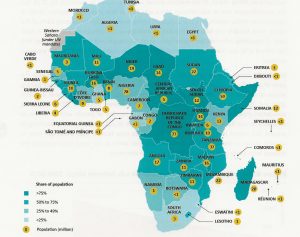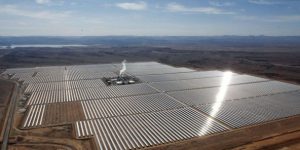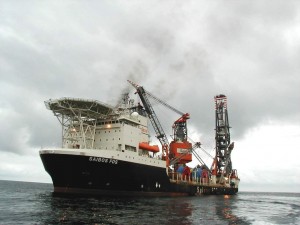In its « Agenda for 2030, » the UN adopted 17 rather large goals for the sustainable development of the planet in September 2015, which are to be achieved by 2030. The seventh is energy with the objective of « ensuring access to adequate, reliable, sustainable and affordable energy services for all. » The UN also recommended a « significant » increase in the share of renewable energy in the global energy mix. This objective specifically concerns Africa, to which the International Energy Agency (IEA) has devoted half of its 2019 report, the World Energy Outlook 2019 (www.eia.org , November 2019), it highlights the challenges it is facing. In 2018, Africa had 1.3 billion inhabitants (1.1 billion in sub-Saharan Africa), 17% of the world’s population, but its consumption represented only 6% of the world’s energy demand (3% for electricity). Per capita energy consumption per year in most African countries is well below the global world average of about 0.7 toe instead of 2 toe, which contributed only 3.6% of global CO2 emissions. While bioenergy (mainly wood and plant waste) accounts for 45% of Africa’s primary energy demand, it is not devoid of resources: hydrocarbons account for 39% of its primary energy mix and coal 13%, it has a very large potential for renewable energy and « critical » metals essential to energy sectors such as cobalt, chromium, uranium and platinum and, moreover, 40% of the discoveries of gas fields between 2011 and 2018 were made in Mozambique, Egypt, Tanzania, Senegal and Mauritania.
This assessment of the situation must be completed with two major observations. The first one being that 600 million people in sub-Saharan Africa do not yet have access to electricity, while the electrification of North Africa is completed cf. map IEA p. 302, light blue electrification completed, green low access to electricity). It is true that countries such as Ghana and Kenya have made a very important effort (84 and 75% of their population being « electrified »). The second is that about 900 million Africans do not have the opportunity to use « clean » energy for cooking, the majority still using primitive stoves (made up of several stones and without a chimney) using charcoal, plant waste or kerosene as fuel and polluting thus the atmosphere. Nearly half a million premature deaths are attributed each year to this pollution, being the cause of respiratory diseases mainly affecting women (who cook…) and children. Progress is being made on both fronts (20 million Africans have gained electricity every year since 2014 but the population is increasing…). Growth in energy consumption in North Africa, Nigeria, South Africa, Mozambique and the Democratic Republic of Congo has contributed significantly to Africa’s growth since 2010 (a 50% growth in the latter two countries).
to use « clean » energy for cooking, the majority still using primitive stoves (made up of several stones and without a chimney) using charcoal, plant waste or kerosene as fuel and polluting thus the atmosphere. Nearly half a million premature deaths are attributed each year to this pollution, being the cause of respiratory diseases mainly affecting women (who cook…) and children. Progress is being made on both fronts (20 million Africans have gained electricity every year since 2014 but the population is increasing…). Growth in energy consumption in North Africa, Nigeria, South Africa, Mozambique and the Democratic Republic of Congo has contributed significantly to Africa’s growth since 2010 (a 50% growth in the latter two countries).
The complete electrification of Africa and access to clean and sustainable energy for all its inhabitants are two major challenges for Africa, whose population will increase as it urbanizes (the IEA envisages a growth of nearly half a billion people in the urban population), urbanization will increase the demand for energy; according to UN population projections, Africa is expected to have a population of nearly 2.5 billion by 2050. The IEA traditionally envisages several scenarios in its 2019 report. Thus, in its « Advanced Policies » scenario, it takes into account the energy policies adopted by States , it assumes that annual energy demand will grow by 2.1% and that one of electricity by 3.6% by 2040. It proposes a more dynamic variant of this scenario, dubbed « Africa case » : it would ensure universal access to energy from all over Africa, especially electricity from 2030 (in 2025 for Côte d’Ivoire, Ethiopia and Senegal), which implies a 10%/year growth in production which is considerable, and greater energy efficiency.
What are the energy options opening up to Africa? The first one is the conventional use of fossil fuels to generate electricity in thermal power plants and that of liquefied natural gas in modern stoves for cooking, but they will run up against the objectives of policies for the mitigation of global warming. The second one is the large-scale exploitation of its renewable energy « reserves ». Its hydroelectric potential is significant, especially in the Congo and Nile basins (hydropower accounts for half of sub-Saharan Africa’s electricity generation, but 90% of electricity is still generated from coal in South Africa, cf. picture Renaissance dam on the Nile). According to the IEA, renewable energy would, according to its scenarios, provide 46% to 75% of electricity generation by 2040, the share of photovoltaic solar and wind energy (important on some coastal regions) would be 20-40% while it was only 2% in 2018, this gives an idea about the importance of the effort to be made (hydroelectric production would double in the « Africa Case » scenario but its share in the energy mix would fall). Photovoltaic solar is well adapted to rural areas far from large electricity grids, but one may envisage building mini-grids around solar power plants (Morocco is developing solar power plants with  concentration cf. picture). For cities, often megacities such as Lagos, Abidjan, Luanda and a few others, their electricity supply via power lines connected to large power plants (thermal with gas, dams, offshore wind turbines on some coastal areas) is inevitable. Finally, abundant biomass (including plant waste cellulose) can be used to make biofuels. Innovations are being implemented to distribute on-demand electricity in some countries such as Kenya: companies install solar panels in a village with mini-grids, connecting households which are thus able to consume a few kWh on demand by connecting to a grid and paying with a smartphone (alternatively they can lease a solar kit with a panel that they install on a roof and pay a rent). The fragility of electricity grids is presently a handicap for the African economy, an issue which it will have to address, notably through regional interconnection. The annual investment required for electrification is considerable, now at $21 billion, but being expected to increase to $45 billion in the IEA « advanced policy » scenario and $100 billion in its Africa case, which is significant and will require an international financing engineering.
concentration cf. picture). For cities, often megacities such as Lagos, Abidjan, Luanda and a few others, their electricity supply via power lines connected to large power plants (thermal with gas, dams, offshore wind turbines on some coastal areas) is inevitable. Finally, abundant biomass (including plant waste cellulose) can be used to make biofuels. Innovations are being implemented to distribute on-demand electricity in some countries such as Kenya: companies install solar panels in a village with mini-grids, connecting households which are thus able to consume a few kWh on demand by connecting to a grid and paying with a smartphone (alternatively they can lease a solar kit with a panel that they install on a roof and pay a rent). The fragility of electricity grids is presently a handicap for the African economy, an issue which it will have to address, notably through regional interconnection. The annual investment required for electrification is considerable, now at $21 billion, but being expected to increase to $45 billion in the IEA « advanced policy » scenario and $100 billion in its Africa case, which is significant and will require an international financing engineering.
The energy transition is necessary in Africa (with the objective of eliminating their CO2 emissions which are still very low) as in other continents, but with the need and urgency to access modern energy (the seventh objective of the Agenda 2030). This transition will pose two problems. Firstly, African oil and gas exporting countries will be affected by the « decarbonization » of energy as many of them are highly economically and socially dependent on the financial  incomes from their exports, accounting for the majority of their revenues. This is the case for Algeria, Nigeria, Angola, and in the short term, Mozambique, but most of them are not prepared for this transition, for lack of investments in industrial sectors. Secondly, it also requests the use of renewable sectors and thus the mastery of new techniques (solar cells, wind turbines, means of electricity storage, etc.) very often covered by patents owned by public companies or research institutes located, overwhelmingly, in Western countries and China (C. Bonnet, S.Carcanague, E.Hache, G.S. Seck, M. Simoon, Towards a more complex geopolitics of energy? IFPEN, IRIS, ANR, December 2018, www.ifpen.fr ); it might block technology transfers to Africa and its access to renewable energy techniques. A research effort is essential to avoid this blockage. Renewable energies technology and « critical » metals needed for their use (such as platinum and cobalt, with which Africa is very well endowed and is an asset it must play) will be an important dimension of a new geopolitics of energy of which China intends to be a leader (it is trying to sell a coal-fired power plant to Côte d’Ivoire that neither the World Bank nor the African Development Bank have agreed to finance…).
incomes from their exports, accounting for the majority of their revenues. This is the case for Algeria, Nigeria, Angola, and in the short term, Mozambique, but most of them are not prepared for this transition, for lack of investments in industrial sectors. Secondly, it also requests the use of renewable sectors and thus the mastery of new techniques (solar cells, wind turbines, means of electricity storage, etc.) very often covered by patents owned by public companies or research institutes located, overwhelmingly, in Western countries and China (C. Bonnet, S.Carcanague, E.Hache, G.S. Seck, M. Simoon, Towards a more complex geopolitics of energy? IFPEN, IRIS, ANR, December 2018, www.ifpen.fr ); it might block technology transfers to Africa and its access to renewable energy techniques. A research effort is essential to avoid this blockage. Renewable energies technology and « critical » metals needed for their use (such as platinum and cobalt, with which Africa is very well endowed and is an asset it must play) will be an important dimension of a new geopolitics of energy of which China intends to be a leader (it is trying to sell a coal-fired power plant to Côte d’Ivoire that neither the World Bank nor the African Development Bank have agreed to finance…).
Energy poses a real challenge to Africa. It must both build infrastructures so that the whole continent will have access to modern energy, and in priority to electricity, for its social and economic development, and prepare to eliminate fossil fuels from its energy mix (of which exports are an important source of income). Regional cooperation across the continent can contribute addressing these inescapable issues.
for its social and economic development, and prepare to eliminate fossil fuels from its energy mix (of which exports are an important source of income). Regional cooperation across the continent can contribute addressing these inescapable issues.
